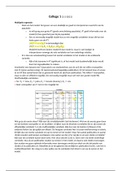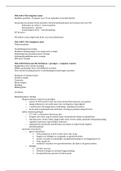Module 3: Student notes 1
Terminology:
Cardiac Output (CO) - volume of blood being ejected by the heart per minute
Stroke volume (SV) – the volume of blood pumped out of the LV in one heartbeat
Preload – the amount of stretch of the myocardial cells before contraction
Afterload – the force that the left ventricle is contracting against
Frank Starling Law – the greater the stretch on the myocardial fibers, the greater the contraction
Law of LaPlace – explains the relationship between the diameter, the volume and the wall thickness
of a sphere and how these factors influence the wall stress of that sphere
Chronotropic – a substance that changes the rate of contraction
Inotropic – a substance that changes the force of contraction
Mean arterial pressure (MAP) – the average blood pressure over the cardiac cycle
Systemic vascular resistance (SVR) – the pressure made of from all the vessels that make up the
entire systemic vasculature system
Pressure overload – the ventricle has an increased pressure to overcome before contraction
Left ventricular pressure overload (LVPO)
Right ventricular pressure overload (RVPO)
Ventricular hypertrophy – an increase in wall thickness, can be a response to a pressure overload or
a cardiomyopathy
Concentric hypertrophy
Eccentric hypertrophy
Concentric remodeling
Compliance/Stiffness – the willingness of a ventricle to fill with blood/ the rigidity of a ventricle that
prevents it from easily filling with blood. Ventricular hypertrophy alters the compliance/stiffness of a
ventricle.
Left ventricular mass – a measure of the size of the left ventricle (increase the number of
myocardiocytes, then the LV mass will increase)
Volume overload – the ventricle has an increased amount of volume of blood (preload) to manage
before contraction
Left ventricular volume overload (LVVO)
Right ventricular volume overload (RVVO)
, Congestive Heart Failure (CHF) – the heart is not able to pump enough to satisfy the body’s
demands and results in the volume of blood backing up into the systemic and/or pulmonary system.
CHF can be a result of a volume overload.
Cardiac reserve – the difference between the resting cardiac output and the maximum output of
the heart during exertion
Exercise intolerance – a decreased ability to perform physical exercise at the level expected
Pressure-Volume loop – a graph to represent the changes in pressure as they relate to the changes
in volume in the left ventricle through on cardiac cycle
Ventricular Interdependence – Physiologically, what happens in one ventricle will affect the other
ventricle. This characteristic is created by the presence of the pericardium encompassing both
ventricles in a non-elastic wrapping and the fact that the right and left ventricles are connected to
each other via the septal walls.
Cardiac Output (CO)
- volume of blood being ejected by the heart per minute. (flow rateà volume per unit of time).
Normal CO is 4 - 8 L /min.
CO = SV x HR (Where HR is the heart rate and SV is the stroke volume.)
1. Heart rate (HR)
Factors that affect the heart rate:
- Temperature
- Parasympathetic, sympathetic nervous system, and SA node
- Hormones
- Chronotropic agents change the heart rate.
o Positive chronotropic agents will increase heart rate
o Negative will decrease heart rate
- Significant tachycardia - If the HR exceeds 160 beats per minute, the heart does not have
enough time to fill resulting in a decreased preload. This causes the stroke volume to be
decreased and the cardiac output to be decreased.
2. Stroke volume (SV) is the amount of blood ejected out in one heartbeat or the end diastolic volume
subtracted from the end systolic volume (EDV-ESV). In a healthy heart, the more blood that returns
to the heart, the more that will be ejected. Normal SV = 60 – 120 mL.
Terminology:
Cardiac Output (CO) - volume of blood being ejected by the heart per minute
Stroke volume (SV) – the volume of blood pumped out of the LV in one heartbeat
Preload – the amount of stretch of the myocardial cells before contraction
Afterload – the force that the left ventricle is contracting against
Frank Starling Law – the greater the stretch on the myocardial fibers, the greater the contraction
Law of LaPlace – explains the relationship between the diameter, the volume and the wall thickness
of a sphere and how these factors influence the wall stress of that sphere
Chronotropic – a substance that changes the rate of contraction
Inotropic – a substance that changes the force of contraction
Mean arterial pressure (MAP) – the average blood pressure over the cardiac cycle
Systemic vascular resistance (SVR) – the pressure made of from all the vessels that make up the
entire systemic vasculature system
Pressure overload – the ventricle has an increased pressure to overcome before contraction
Left ventricular pressure overload (LVPO)
Right ventricular pressure overload (RVPO)
Ventricular hypertrophy – an increase in wall thickness, can be a response to a pressure overload or
a cardiomyopathy
Concentric hypertrophy
Eccentric hypertrophy
Concentric remodeling
Compliance/Stiffness – the willingness of a ventricle to fill with blood/ the rigidity of a ventricle that
prevents it from easily filling with blood. Ventricular hypertrophy alters the compliance/stiffness of a
ventricle.
Left ventricular mass – a measure of the size of the left ventricle (increase the number of
myocardiocytes, then the LV mass will increase)
Volume overload – the ventricle has an increased amount of volume of blood (preload) to manage
before contraction
Left ventricular volume overload (LVVO)
Right ventricular volume overload (RVVO)
, Congestive Heart Failure (CHF) – the heart is not able to pump enough to satisfy the body’s
demands and results in the volume of blood backing up into the systemic and/or pulmonary system.
CHF can be a result of a volume overload.
Cardiac reserve – the difference between the resting cardiac output and the maximum output of
the heart during exertion
Exercise intolerance – a decreased ability to perform physical exercise at the level expected
Pressure-Volume loop – a graph to represent the changes in pressure as they relate to the changes
in volume in the left ventricle through on cardiac cycle
Ventricular Interdependence – Physiologically, what happens in one ventricle will affect the other
ventricle. This characteristic is created by the presence of the pericardium encompassing both
ventricles in a non-elastic wrapping and the fact that the right and left ventricles are connected to
each other via the septal walls.
Cardiac Output (CO)
- volume of blood being ejected by the heart per minute. (flow rateà volume per unit of time).
Normal CO is 4 - 8 L /min.
CO = SV x HR (Where HR is the heart rate and SV is the stroke volume.)
1. Heart rate (HR)
Factors that affect the heart rate:
- Temperature
- Parasympathetic, sympathetic nervous system, and SA node
- Hormones
- Chronotropic agents change the heart rate.
o Positive chronotropic agents will increase heart rate
o Negative will decrease heart rate
- Significant tachycardia - If the HR exceeds 160 beats per minute, the heart does not have
enough time to fill resulting in a decreased preload. This causes the stroke volume to be
decreased and the cardiac output to be decreased.
2. Stroke volume (SV) is the amount of blood ejected out in one heartbeat or the end diastolic volume
subtracted from the end systolic volume (EDV-ESV). In a healthy heart, the more blood that returns
to the heart, the more that will be ejected. Normal SV = 60 – 120 mL.










